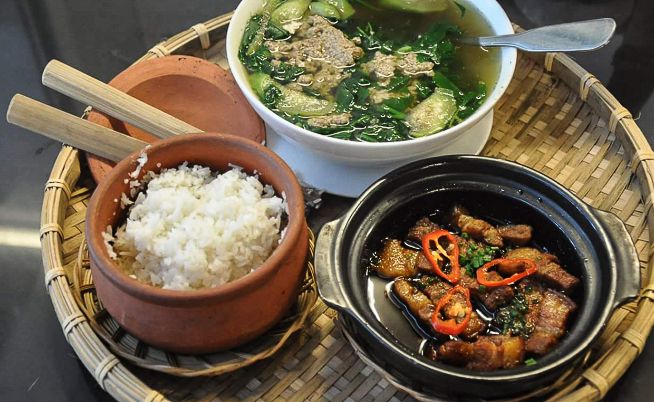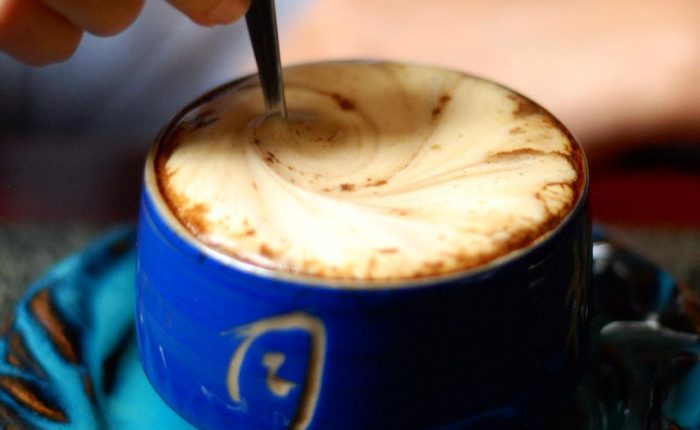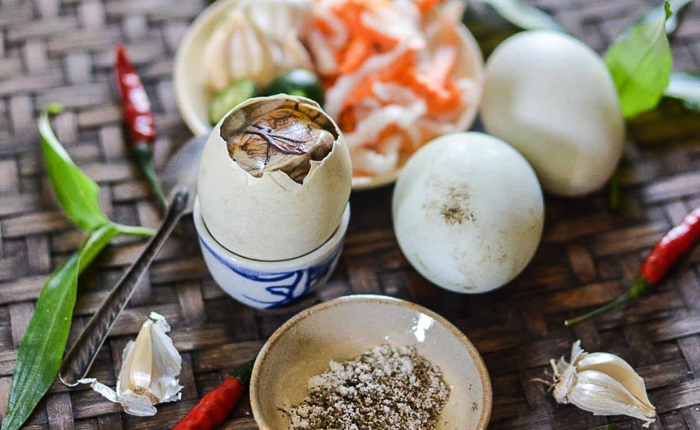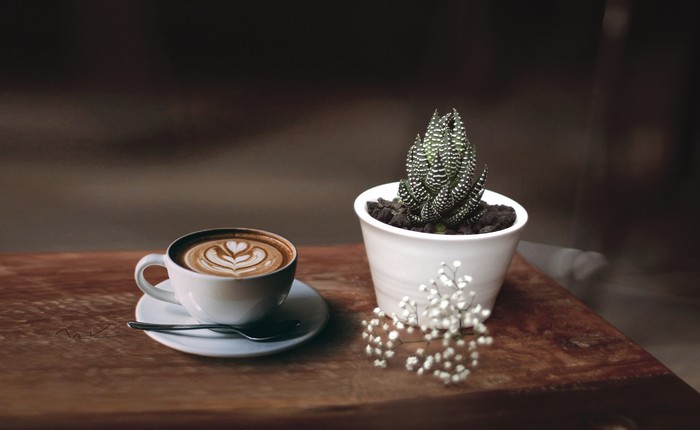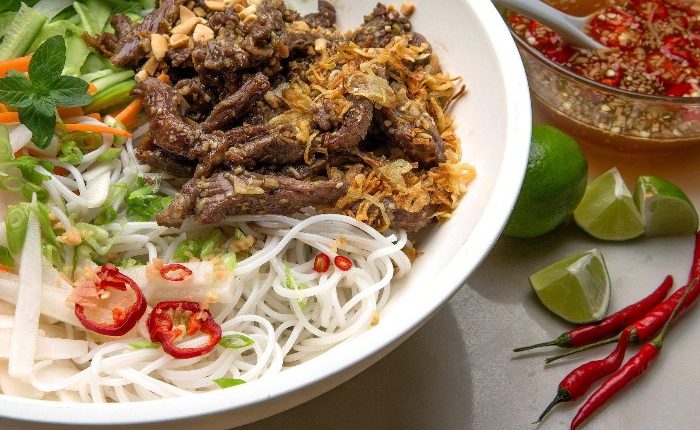Whatever place you are coming from, you probably encountered Vietnamese cuisine even if you have never visited the country. Famous for noodles, soups, rice, spring rolls and thanks to the history baguette or coffee too, Vietnam is definitely a spot that should be on your gourmet travel list.
We are locals and we love our traditional Vietnamese dishes, but there was also a huge cultural influence during the colonial times. Let’s take a trip down memory lane with the3 most famous dishes.
Banh Mi

One of the most famous street food snacks is Bánh Mì or Banh Mi, a delicious savoury baguette. Are you guessing French have to do something with it? You are right. “Banh” is the Vietnamese word for bread and type of baguette crusty on the outside and soft on the inside, which can be split and filled with yummy ingredients.
Prepare your napkins, here they are: minced pork, pork sausage, cilantro also known as coriander, Vietnamese mint, cucumber, soy sauce, Maggi sauce, fried eggs, pickled veggies, sardines, cheese, meat pate, chilli, mayo…
Not all Banh Mis are created equal, they vary from food stall to food stall, city to city. In general, the Northern you go, the fewer vegetables and more meat. Following the Vietnamese war, these baguettes became quite popular overseas too, but if you visit Vietnam, you should definitely give these a try:
- Hanoi – Banh Mi Pho Hue, No 118A, Hue Street
The shop has been open since 1974 and it is one of the oldest shops selling this beauty. We highly recommend the pate here. Bread is very crispy and soft at the same time. And it is just about 1 mile (1.6 km) from the Old Quarter. Need more reasons? - Ho Chi Minh (Saigon) – Banh Mi Huynh Hoa, 26 Le Thi Rieng Street
Like to get filled on the fillings? This place in Saigon will not disappoint. Best value for money. There are so many mouth-watering layers of pate, meat, and crunchy veggies you might just need to loosen that belt. If you will arrive here and see a queue, wait for it. It is worth it. Secret tip: if you do not like red hot chilli peppers (and now we do not mean the band) mention it. Things can get steamy at Huynh Loa. - Hoi An – Banh Mi Phuong 2b Phan Chu Trinh Street
Food bloggers sing praises, Anthony Bourdain said it is the best Banh Mi he ever had.
With a bakery next door, this is as fresh as it gets. Oh and the variations… We guarantee you will have to make Sophie’s choice while browsing the menu. Or come back for more.
Coffee

Another sign of French influence that started when the Indochinese Union was formed in 1887, is drip coffee. We bet you have never seen so many coffee shops in one street as in Vietnam. France learned to drink it from the Middle East and later broaden the horizons here. The most popular version of coffee is served cold and with condensed milk, brewed using a Phin. Buy one of these filters as a souvenir, you will not regret it. 3 tips:
- If you want the sweet version, get Ca Phe Sua Da. If black as night, Ca Phe Den Da. Da means iced so if you like it hot, skip it. Then say to the barista “Đen Nóng” or “Cafe Phin”.
- A must-try is a coconut coffee (Cà Phê Cốt Dừa). This drupe fruit is very popular here and you often see people sipping on coconut water from a freshly cut coconut. This coffee with condensed milk and coconut milk over ice is perfect in hot summer days.
- It can be found in Saigon but if you find yourself in Hanoi, you’re in for a treat called Ca Phe Trung aka egg coffee. Egg yolk is whipped together with condensed milk and topped with coffee. Enjoy it on the famous “train street” or right where it was born, Cafe Giang.
Banh Xeo

A third meal that we want you to know about is Vietnamese crepe aka the sizzling cake. Vietnamese name of this dreamy street snack is Banh Xeo. Same as banh mi, there are several fillings and it comes with fish dipping sauce on the side. Vietnam is famous for its fish sauces, we recommend the one from Phu Quoc island.
Another purchase should be chilli+salt mix and pepper, they grow 4 kinds and it is one of the best on the market. Even if banh xeo looks like it is made from eggs, the main ingredients are rice flour, coconut milk, mung beans, and turmeric. Give it a try, it is cheap and starchy.
French also popularised desserts, hot pie with meat filling, potatoes, asparagus, onions or shallots. Oh là là.
Find out 10 interesting facts about Vietnamese cuisine ➡
Not that we brag but Vietnamese cuisine really is the best 🙂 How to draw a picture of not previously mentioned specialities without overwhelming you? We decided to group food you should not miss when in Vietnam into 5 groups. We get that you are hungry at his point. Go grab yourself a snack and relax with the list of our favourite dishes from every group:
Rice dishes

Hard to avoid rice, rice noodles and rice paper in Vietnam. But why would you want to? Take locals and their love for the noodlastic soup Pho, they eat it for breakfast (rice and shine!), lunch, and dinner. Back to basics: give Broken rice or Com Tam a try. Tấm” or broken rice is rice which has been broken into small pieces and is popular in the whole country, mostly South.
When in Saigon, enjoy it with a beer of the same name and caramelized pork chop (marinated in a mix containing fish sauce) or cake made of pork fat, pickled vegetables, steamed egg/mushrooms/noodles (called Trung Hap). If you love garlic and chilli, there are always some on the table to add extra flavour.
Broken not enough? Try Beaten/Smashed/Flying rice. Really, that are the name varieties. Treat yourself and go to a nice restaurant where skilled personnel will bring you Claypot rice (Cơm Niêu) or Smashed rice (Com Dap). Again, Anthony Bourdain made it popular with his “Cook’s Tour” that featured a flying-rice show and shattered-crockery at Com Nieu Saigon restaurant.
What about rice in a leaf? Try Banh la or Banh Tt (triangular shape). Unwrap the jackfruit, pinnate, banana or water coconut leaf and dig into the sticky rice mixed with beans, meat, shrimp. It is a common local street food as well as family celebrations dish.
Noodle dishes
Udon know that we ramen in love with our noodles in Asia?! Well, according to the World Instant Noodles Association, Vietnam was the world’s fifth largest instant noodles consumer in 2017, consuming more than 5 billion packs!
There are many types of noodles to try: flat pho noodles, thin rice vermicelli, egg noodles, tapioca ones, glass noodles or more thick noodles like Cao Lau and Banh Tam Bi.

And the noodle dish that is worldwide most famous and is the No 1 on our list is Pho soup. Phở (pronounce as f) was born in the North (pho bac) as an offspring of French soup “pot au feu”, which is more of a stew. Again, there are differences between the Northern (Pho Bac) and Southern Vietnamese Pho (Pho Nam) but one thing makes it similar: long-simmered broth of chicken or beef bones (or combo) with onions/ginger/fish sauce/coriander, etc. to add aroma. Try it is served with noodles and topped with herbs. You can find chilli, sauces, pepper and key lime on the table to sneak in extra flavour if you fancy. This is a comfort soup – a soup for the soul.
Meat and Seafood

Meat is very popular. To get you into the lingo: thịt means meat, ga means chicken, bo means beef, heo means pork, dê is goat, vịt is duck, cá is fish, hai san is seafood. Those are the most popular. Which dishes make us salivate the most?
Gà Rang Muối or pieces of chicken fried with chilli and garlic then tossed in a mix of salt, pepper, and lemongrass, topped with fried scallion. Great as finger food with beer.
Bánh Cuốn, steamed rolls, served with Vietnamese ham and blanched sprouts, stuffed with ground pork, mushrooms, and veggies. Again, content depends on location. It is light yet fulfilling. Pick the rice batter roll, dip in the fish sauce and your day is instantly better. There are plenty of rolls in Vietnam, spring rolls (goi cuon), tofu rolls (Dau Hu Cuon), rolls with sausage in them (Nem Nuong Cuon), grilled rolls (Bo Nuong Cuon) and we can go on and on. In Vietnam, the diet can start tomorrow, just roll with it.
Vietnam has a rich fauna and underwater world. Just the island of Cat Ba, located in Lan Ha Bay has 900+ types of sea fish. Oru favourite sea creature is definitely crab, called Cua. Get it in soup, rolls, or with tamarind sauce (Cua Rang Me).
Vegetable dishes

Vegetables and fruits are a feast for the eyes. Visit one of many markets and walk around like you are in your own travel culinary show. We recommend going with someone local, or if you book a tour with a local agency, this will be most likely included in your itinerary. Firstly, you might feel overwhelmed by the attention you will get as Tây (a foreigner), secondly, you will be lost in translation. But it will be one of your fondest memories. Markets to look out for:
- Hanoi – Dong Xuan Market in the OQ (Old Quarter), established in 1889
- Saigon – Xóm Chiếu Market, Lê Văn Linh Street, one of the largest in the city
And a bonus if you will be looking for already cooked veggies: Located in a 5,000-square-meter basement at Zone B, Pham Ngu Lao Street in District 1 of Ho Chi Minh city, you can find a market called Asiana Food Town, with than 70 stalls and 1000 foods!
So, what are the most popular vegetables in a Vietnamese household? Sprouts, cabbage, chayote, bitter melon, bok choy, lettuce, cucumber, onion, shallots, chilli peppers and drumroll, our 3 favourites:
Water spinach also called morning glory. It grows in damp soil but the taste is heavenly. And it is cheap and simple: just stir fry with garlic, fish/oyster sauce, chilli, sugar. Some people add soybean paste too.
Sweet potatoes (more popular than regular ones), called Khoai Lang in Vietnamese are another one of cheap but filling treats. There is even a soup made from leaves!
We love pickled veggies too and recommend you to try pickled mustard greens (Dưa Cải). They taste great with meat and rice.
Sweet dishes and fruits
The most popular sweet dish you will see daily when you visit is Ché = sweet “pudding-y or soup-y” beverage. Mix coconut milk, seeds, fruits, aloe vera, beans, veggies, cassava, tapioca, rice… Sounds wild? Well, there are plenty of versions. Try Chè đậu đen in North (with black beans) and Chè đậu phụng (with peanuts) in the South. Or just close your eyes and point your finger. We bet Forest had it and said to himself, “Ché menu is like a box of chocolates. You never know what you’re gonna get.”
Craving donuts? Try local version, Banh Tieu with sesame seeds. Crispy and hollow, but with a full-taste balance of sweet and savoury. Watch street vendors throw them into the oil until they puff up.
And last one, famous icecream Trang Tien Ice Cream, a must-eat on a hot Hanoi day. Located in 35 Tràng Tiền, near Hoàn Kiếm lake, lies a famous shop established in 1958. If you see people lined all the way to the street, you found the place. Try com (green rice flakes) or dau xanh (green bean)

And how about fruits? Oranges, mangos, and bananas you know. But how about mangosteens, guava, rambutans, dragon fruit or star fruit? And popular among locals: durian. Famous for being smelly but nutritious, we recommend you Cai Mon, durian from the Mekong Delta.
Did you master chopsticks already? Wondering about eating culture and customs in Vietnam?
Here are basic facts about serving food:
- Spoons – They are used mainly for soups, fried rice and Ché mentioned above. Knives and forks are rare. Which leaves us with:
- Sticks – Can be a challenge, we know. Try practising on noodles or sticky rice. Hold the upper chopstick (thinner end points down) like a pencil, put the second chopstick between the thumb and index finger or push it against your ring finger, with the thumb as the “controller”, then try to move the upper chopsticks like scissors. Every country has its own style, let’s call this one a mix between Vietnamese and Japanese, easy for beginners. Who knows, you might enjoy them so much you will bring some nicely decorated ones home as a souvenir.
- You may encounter unusual things when eating out. Sealed wet wipes that will lend on your table are not for free (however they are only about 5000 VND – 0.2 USD) and some places have an extra 10% service charge. Beer comes with ice in the summer. There is no salt on the table but usually a pepper, soya sauce, sesame or chilli oil. Or previously mentioned the mix of a bit of salt, pepper, and key lime.
- Love cooking? Then you will adore hot pot. It is a dish that embodies the saying “sharing is caring”. There are 3 main ingredients: broth, things to boil and sauces. The broth is made from veggies, chicken, beef, pork bones or ribs or from seafood. And what do you dip inside? Sliced meat, dumplings, fish, seafood, veggies, tofu… and noodles. What goes in first? Meat, you need to allow it some time to cook. Then veggies and noodles. Locals save broth as the last and sip it from the bowl. Also, the longer it simmers the tastier it is. Basically, just wait for ingredients to boil and take them into your bowl, hold them with chopsticks, dip them in minced herbs, fish or soya sauce, with pickled veggies on the side and straight to the mouth they go!

We hope you found this article packed with useful info.
Many foodies swarm Vietnam in last years. We take the liberty of quoting one of them:
“Does everybody fall in love with the country as I did? I came here and it stole my heart.”
The late great chef Anthony Bourdain
Well, visit Vietnam, meet locals, chat over a coffee or bia (beer), break bread with them and find out for yourself.

